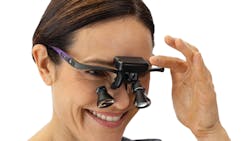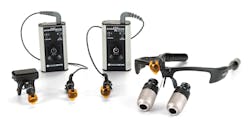Twenty-four years ago, I ordered my first headlight. After using magnification for a year, it was the next logical step. My budget was tight, so I opted for a less expensive device. It was an exciting purchase, but I quickly learned three important lessons. Lesson number one: Having illumination was supposed to be amazing, but the product was not a “wow.” It was clunky, the light was dim and full of shadows, and it had to be plugged into an active light socket. Lesson number two: If a product is going to help you make a change for the better, buy the best you can afford. Lesson number three: Know where you stand when you purchase a product. While I did not like that first headlight, it came from a company that had a 45-day money-back guarantee. I knew I was protected, so I took a deep breath, contacted the company, and sent the device back.
I then purchased a new headlight. It cost twice as much as the first one, but I ordered it anyway. This was a huge step. My budget was on a financial tightrope, but I knew my decision was protected by the company’s trial period. Within a week, the second headlight arrived. Even though it would never pass today’s standards, it was love at first sight. The headlight was attached to a long, heavy fiber-optic cable that plugged into a big gray box that housed a halogen projection bulb. The spot was not so shadowy, and it cast a brighter light into the oral cavity. (Quit laughing. It was 1997 and this was the state-of-the-art.) This is where my lighting journey began.
Today’s lighting options
Fast forward to today. The headlight options we have now would have been in the realm of science fiction just years ago. There are many types of headlights available, and recent lighting advancements are amazing. Today’s clinicians would never consider being tethered to a light source housed in a box. We want portability and freedom.
The marketplace is crowded. Inexpensive online systems can go for less than $50, while the cost of newer, high-quality illumination systems is at the other end of the pricing spectrum. Keep in mind there are significant differences in product quality and performance. Inexpensive products offer limited light output, tend to break easily, and can overheat, creating a burn risk. Higher-end products are built to last and deliver uniform, quality lighting for years to come.
Improvements include spots that are uniform from edge-to-edge, longer-lasting rechargeable batteries, cordless headlight systems, and detachable battery cables that are easy to replace.
Getting updated
Paige Seaborg, RDH, has practiced full-time dental hygiene for decades and decades. Paige started using loupes 20 years ago. A few years back, her doctor gifted her with his old headlight, which broke shortly thereafter. It was never replaced. Last spring Paige chose to leave a practice after many years. It was a tough decision and she took the loupes with her. After she resigned, the doctor wanted Paige to pay him $1,000 for the loupes. He still owed her money and she declined.
As Paige entered the temporary workforce, she quickly realized her loupes needed upgrading. It was time to investigate lighting options. In June 2019, she ordered two new products at the Pacific Northwest Dental Conference: Orascoptic TTL loupes with the new EliteEdge frame and the Spark headlight. It was fun to watch her make the selection. This was a big financial commitment, but Paige walked away feeling confident that she made the right decision.
Two weeks later, her custom loupes arrived. She was thrilled. Then, an unexpected bonus showed up within two weeks. A few years back, Paige was in a car wreck. Her nagging shoulder ache never resolved despite physical therapy and swimming on a regular basis. Suddenly, the pain was gone. Paige chalked up her relief to not having to reach for the overhead light. Her purchase was paying off. The lightweight customizable frame helped as well. She had the right magnification and lighting systems to customize her workspace to fit the physical demands of different offices. Her journey to find the right dental home was now easier.
Now what? A technological breakthrough
About a month after Paige made her purchase, Orascoptic launched a new version of the Spark, made with TruColor technology. From a clinical perspective, the color rendering in the new headlight was a huge leap forward. So, what does this really mean? The CRI (color rendering index) measures how colors look under natural sunlight.
Prior to TruColor technology, no headlight systems exceeded a CRI of 71. The higher the CRI, the more natural the color appears to the user. The TruColor CRI measures 90-plus. If you shine a 70-CRI headlight on a red apple, a peach, or a banana, you will see the color. By comparison, a 70-CRI product on an apple shows a distinct difference. The TruColor light shows a richer, deeper red and more subtle shades of red in the apple skin.
While we’re not looking at fruit in the clinical setting, we are looking for bleeding points, soft tissue redness, and abnormal lesions. We also look at variations in tooth color, marginal integrity, and restoration breakdowns. Each of these visual challenges requires optimal lighting. Accurate color rendering plays a key role in our diagnostic evaluations.
As soon as I got my hands on the TruColor headlight, I was in love all over again. It was immediately clear that the new CRI level was going to make a clinical difference. The following day, I was scheduled to meet with dental hygiene students at Pierce College. This program focuses on how the right equipment can have a positive physical and career impact. The students saw the difference immediately during the headlight demonstration.
Now, back to Paige. While she was loving her Spark light, she needed to see and experience the TruColor innovation. Since she was still within her 45-day trial period, there was no problem swapping out the original headlight for the new model. It was déjà vu.
Paige got the ball rolling immediately, but to make the exchange she had to return her original Spark. I had an ulterior motive, so I hatched a plan. I wanted to see if Paige could see what I was seeing, so I loaned Paige my original Spark. She was the perfect impartial tester. She could literally test the two technologies against each other in a variety of different clinical settings.
Paige used the new TruColor Spark on the first test day on every morning patient. At noon she switched back to the original Spark, but after two patients, she could clearly see the difference. From that point on, she used the TruColor system. Paige focused on the enhanced soft-tissue colors. After a few days, I asked about tooth colors and restorations. She was able to see subtle color differences. Paige’s experience confirmed my suspicions. The TruColor lighting system was making a difference in her clinical world.
Like many dental professionals, Paige has developed noise-induced hearing loss to the point that she now needs hearing aids. Without her hearing aids, sounds are flat and she misses parts of conversations. But when she has them in, she is able to enjoy the whole conversation with much richer tones and inflections. To Paige, the TruColor enhancement was as valuable to her visual acuity as hearing aids were to how she hears the world.
Last month, Paige booked a Friday temp job—but she forgot to take her new loupes and TruColor light home the previous night. Fortunately, she had her 20-year-old loupes . . . but no headlight. Paige’s day was miserable. From that point on, Paige decided she would always leave her car keys in the travel case to ensure she’ll never have to work with old equipment again.
The nuts and bolts: Making a purchase decision
Any new purchase should create value and have a positive impact. Important considerations include asking the following questions:
• Will the product improve diagnostic abilities?
• Will the technology make the clinical day easier?
• Is the product made from quality components?
• Is the product compatible with other systems?
• Is there a money-back trial period?
• Does the product come with a reasonable warranty plan?· Is the product easy to maintain?
Thoughts for newbies
There is a saying in the dental manufacturing world that it takes 10 years for an idea to catch on. In our world, most ideas or items are considered new and innovative for a decade before being considered the standard of care. Loupes and lights are no different. Recently, two hygienists shared their unique illumination experiences with me. Neither is a newbie to the profession, but neither had used magnification and illumination. Here are their stories.
Kathleen Litru, RDH, graduated in the late ’80s and has been in the same practice for years. Both her new young doctor and the other hygienist who recently joined the practice use loupes and lights. Kathleen wanted to practice another decade. Despite using a saddle stool in recent years, her neck aches were becoming more and more frequent—a clear signal that her days might be numbered. Sixteen years ago she purchased loupes, but the product never worked well. The loupes were too heavy and simply collected dust in a drawer.
Kathleen followed online chats. She became convinced she was missing critical items that would help her reach her goal. Kathleen found out the South Dakota Dental Hygienists’ Association was hosting a continuing education event that included an ergonomics course. It was a perfect opportunity to get measured and learn about other strategies to safeguard her body and career.
Kathleen made a commitment. She signed up for the program. The event was four and a half hours away and in another state, which meant a long drive, a hotel room, and other travel incidentals. But Kathleen was on a mission. She was focused on two things: finding the right products and getting measured correctly. On the drive back to Iowa, she knew she had made a good decision.
Fast forward one month into using magnification and illumination. Kathleen had an accident and fell, fracturing her humerus. (Which, in her words, was not humorous. Don’t you just love a good pun?) Fortunately, the break was not completely through. But if it did not heal correctly, her future would include rotator cuff issues. Her new RDH Elite loupes, cordless Spark TruColor light, and saddle kept her upright and close to the patient. This positioning kept her arm close to her torso, and the headlight eliminated the need to constantly adjust the overhead light. Kathleen has no regrets.
Tonya Goehr-Anderson, RDH, a seasoned hygienist with several decades of clinical practice, had never used loupes or a headlight. After extensive research, Tonya scheduled an appointment with her local representative. While he patiently demonstrated all options using a typodont, the best part was yet to come. Tonya’s doctor was the perfect mock patient to compare TruColor lighting technology against the previous generation in the clinical setting. “I was amazed the TruColor light did not have the blue hazy appearance,” she says. Tonya is currently waiting for her order to be delivered, but is convinced the magnification and light will improve her clinical findings and extend her career.
Lighting principles
Unless you are a supergeek, it is really easy to assume that all light sources are the same. But just a little knowledge about basic lighting science reveals otherwise.
There are four basic principles in lighting: illumination, foot candles, intensity, and color.1
Illumination is light or the act of lighting up an area. Overillumination occurs when there is more artificial light than required.1 The adverse health effects of overillumination include headaches, fatigue, stress, and high blood pressure.
Foot candles refers to the amount of light that actually falls on a surface. It is used to calculate adequate lighting levels.
Intensity is measured in watts and lumens. A standard 100-watt incandescent light bulb emits approximately 1,700 lumens.1
The actual color of a light is measured on a scale called degrees Kelvin. A 5500 K reading matches daylight. Light below 4000 K appears reddish, and readings above 7500 appear bluish.1
TruColor technology: Features and benefits
• Uniform round spot
• Brightness does not diminish
• No decrease in light output, spot control, or battery run time
• Available across the entire lighting product platform
• Can be used with most loupe frame options Blue-light compliant
The value of proper lighting
Adequate lighting is important in the workspace. Lighting design principles are important to creating an optimal lighting experience. Human visual performance depends on both light quality and quantity. The amount and quality of the light should match the function. Use task lighting to supplement ambient lighting.1,2
Adjustable task lighting contributes to visual comfort and reduction in fatigue.3,4 Good lighting provides sufficient illumination, eliminates shadows, and supports accurate color rendition.1,2,4 Poor visual conditions can lead to eye fatigue, slow workflow, create unnecessary postural demands, and compromise overall performance.2–4 As the workforce ages, the importance of accurate lighting increases.5,6 A recent study demonstrated LED lighting positively affected both performance and alertness in computer-based and paper-based activities. The study subjects preferred LED lighting over three types of fluorescent lighting and found LED lighting the most comfortable.7
The properties of color
Color is reflection of light from a pigmented surface. Light is required to see color, and the human eye transmits the visual sensation to the brain. There are also psychological responses to color. Color can stimulate an emotional response. An individual’s personal response to a specific color can be varied. Color gets even more complicated. Within a particular color, such as red, there are a variety of hues, shades, and color saturation.
According to lighting industry experts, CRI is one of the most important aspects of lighting. CRI measures how well a light source makes a color look realistic to the human eye.8 As LED lighting has become more common, CRI has become an important factor in selecting lighting options in the workspace.9 The higher the CRI, the more accurate the color discrimination,10 an important benefit to clinical practitioners when evaluating soft tissue, detecting lesions, and viewing restorations and tooth structure in and around the oral cavity.
Final thoughts on CRI technology
Orascoptic’s innovative TruColor headlight technology is in a class by itself. TruColor provides a more precise view of both hard and soft tissues, resulting in better diagnostic decisions, more accurate treatment outcomes, and reduced eye strain. TruColor technology’s boost to visual acuity is simply amazing!
Editor’s note: This article is sponsored by Orascoptic. Content has been reviewed for editorial integrity per RDH guidelines. For more information on RDH standards of editorial excellence, see rdhmag.com/page/submission-guidelines.
References
1. Efficient lighting strategies. Wise design choices can meet design needs and save energy. Department of Energy. Published December 2002. https://www1.eere.energy.gov/buildings/publications/pdfs/building_america/26467.pdf
2. Lampi E. The sources of light and lighting at work. Acta Ophthalmol Suppl. 1984;161:66-83.
3. Joines S, James T, Liu S, Wang W, Dunn R, Cohen S. Adjustable task lighting: Field study assesses the benefits in an office environment. Work. 2015;51(3):471-81. doi: 10.3233/WOR-141879
4. Dianat I, Sedghi A, Bagherzade J, Jafarabadi MA, Stedmon AW. Objective and subjective assessments of lighting in a hospital setting: Implications for health, safety and performance. Ergonomics. 2013;56(10):1535-45. doi:10.1080/00140139.2013.820845
5. Nylén P, Favero F, Glimne S, Teär Fahnehjelm K, Eklund J. Vision, light and aging: A literature overview on older-age workers. Work. 2014;47(3):399-412. doi: 10.3233/WOR-141832
6. Hammond S, Bowen PG, Hallman MG, Heaton K. Visual performance and occupational safety among aging workers. Workplace Health Saf. 2019;67(10):506-511. doi: 10.1177/2165079919848444
7. Kazemi R, Choobineh A, Taheri S, Rastipishe P. Comparing task performance, visual comfort and alertness under different lighting sources: An experimental study. Excli J. 2018;10(17):1018-1029. doi: 10.17179/excli2018-1676
8. What is color rendering index and why is it important? LED Watcher. https://www.ledwatcher.com/what-is-color-rendering-index-and-why-is-it-important/. Published June 13, 2016.
9. Understanding color rendering index. Lumens. https://www.lumens.com/light-bulb-facts/color-rendering-index.html
10. Why is CRI important? Elemental LED. https://www.elementalled.com/why-is-cri-important-2/
ANNE NUGENT GUIGNON, MPH, RDH, CSP, has received numerous accolades over four decades for mentoring, research, and guiding her profession. As an international speaker and prolific author, Guignon focuses on the oral microbiome, erosion, hypersensitivity, salivary dysfunction, ergonomics, and employee law issues. She may be contacted at [email protected].
About the Author
Anne Nugent Guignon, MPH, RDH, CSP
ANNE NUGENT GUIGNON, MPH, RDH, CSP, has received numerous accolades over four decades for mentoring, research, and guiding her profession. As an international speaker and prolific author, Guignon focuses is on the oral microbiome, erosion, hypersensitivity, salivary dysfunction, ergonomics, and employee law issues. She may be contacted at [email protected].


